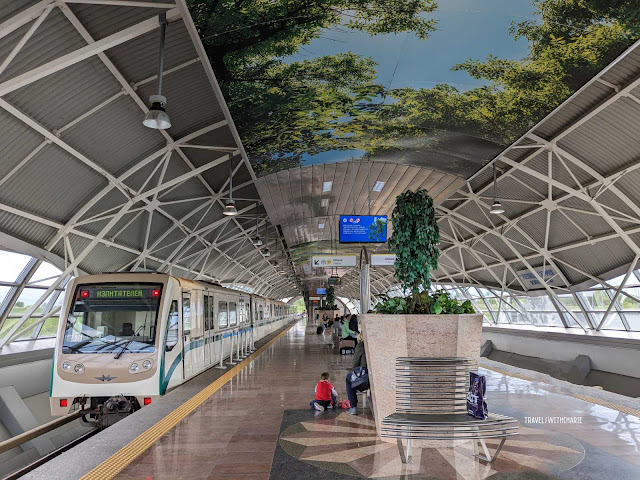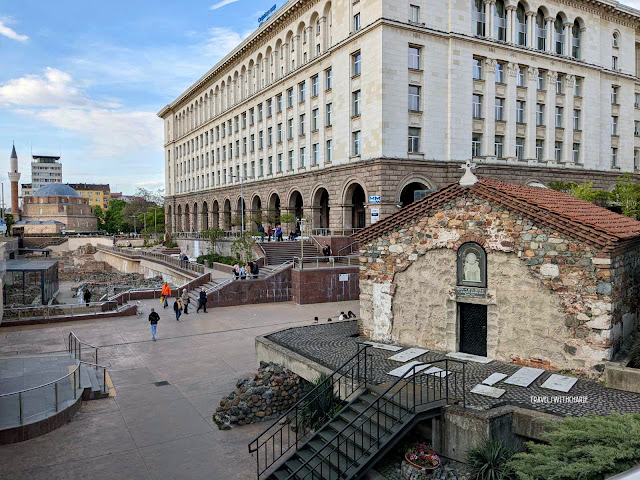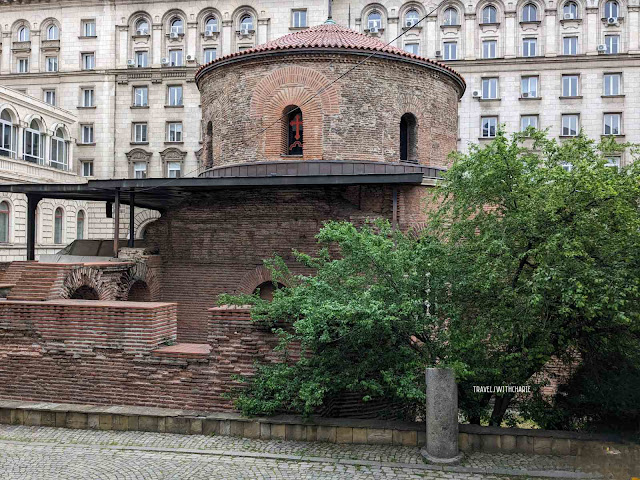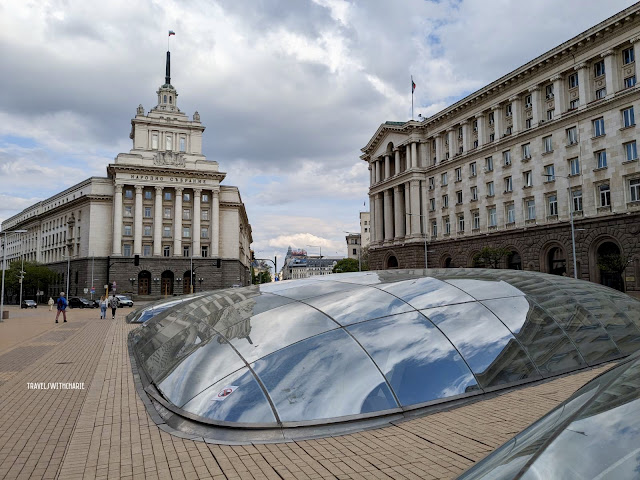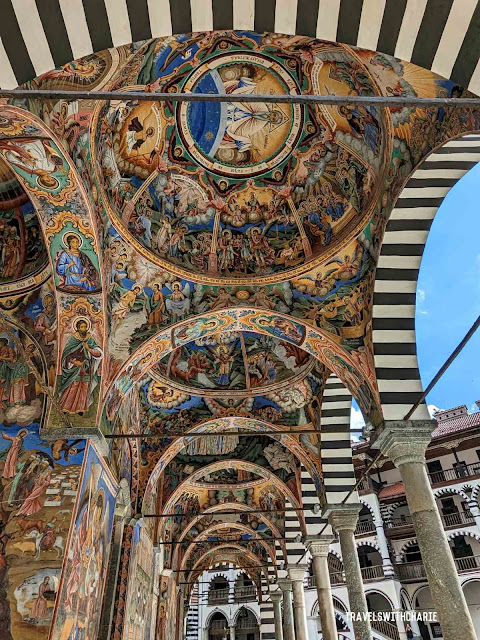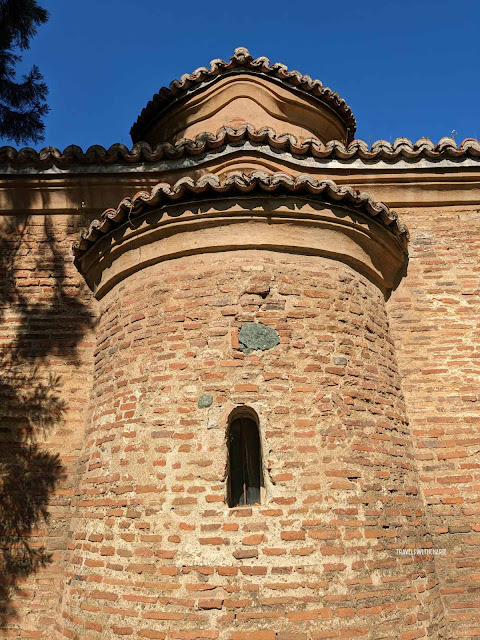Sofia Airport Metro Station
1 Easy to navigate
Sofia is not a big city when compared to other European cities like Paris or Berlin. This means that walking around the city can be a pleasurable experience and no crowds to jostle with. The metro system is simple and easy to use and gets you to the center of the city from the airport in 30 minutes for only 1.60 BGN. There are monitors in the train that show the next stop and an announcement both in Bulgarian and in English as the train approaches a station. It’s best to buy a day ticket if you plan to use the metro throughout the day.
2 Several historical landmarks are in the same neighborhood
St. Petka Church, Roman ruins, Banya Bashi Mosque
When you get off at Serdika Metro station, you’ll find the Roman ruins just outside the exit door. There’s no need to go up the stairs and cross the street to the Largo area. Beside the ruins are the Banya Bashi Mosque from the 16th century, a remnant of the Ottoman rule in Bulgaria and the elevated Church St. Petka of the Saddlers, a medieval church built in the 11th century.
St. George Rotunda
Across the street from the Largo is the hidden Church of St. George Rotunda from the early 4th century. It was originally built as a Roman bath and later converted to a church. You’ll find it in the courtyard of a cluster of government buildings. From pl. Nezavisimost, go past the Sophia Balkan Hotel and take a left on Saborna Street and then take the first left turn on Tsar Kaloyan Street. Don’t miss the Sveta Nedelya Cathedral which faces Saborna Street.
3 History at your feet
Archaeological excavation site
Sofia is one of the oldest capitals in Europe. When you walk around town, you’re stepping on layers of history. This glass bubble protects the ruins of the ancient settlement of Serdica below. Notice the building in the background with a cupola. This was the headquarters of the Central Committee of the Bulgarian Communist Party and now used for government offices. This building called the Party House is a fine example of Stalinist architecture.
St. Alexander Nevsky Patriarchal Cathedral
The Cathedral which is one of the biggest Eastern Orthodox buildings in the world, was built to commemorate the soldiers who died during the Russo-Turkish war of 1877-78 which resulted in the liberation of Bulgaria from Ottoman rule.
Interior of the Cathedral
Taking photographs inside the Cathedral is prohibited.
5 Eat, drink, stroll, shop on Vitosha Boulevard
Vitosha Boulevard
Long pedestrian street in the heart of the city with restaurants, bars, cafés and shops scattered along the way. I especially love the flowering trees. This area is a short walk from Serdica metro station. You can see Vitosha mountain in the distance on a clear day.
There are also Instagrammable spots along Vitosha Boulevard.
6 Vitosha mountain is so close to the city
Vitosha Mountain and Sveta Nedelya*
What struck me most about Sofia is the imposing presence of the mountain. I was pleasantly surprised that the mountain peaks were still covered in snow in May. Vitosha Mountain has become a popular destination on its own with hikers and mountaineers from around the world.
*Image from Wikimedia file Creative Commons CCO 1.0 Universal Public Domain Dedication. Author: Stolichanin
7 Evocative sculptures in public spaces
Sveta Sofia
Saint Sofia balances on her arms an owl and a wreath which are the symbols of wisdom and peace, respectively. This rather controversial statue is not about Saint Sofia, the patron saint of Sofia, but rather a representation of the goddesses Minerva and Athena.
Rest, Velichko Minekov, 1961
This sculptural piece is lodged outside the walls of National Art Gallery. On Pl. Knyaz Alessandra I.
Orpheus, Krum Damyanov
Orpheus is ensconced at the Sofia airport metro station.
Liberation from Communism
One of several monuments to commemorate Bulgaria’s liberation from communism in the garden in front of Alexander Nevsky Cathedral. At the corner of Georgi S. Rakovski and Oborishte Streets.
National Archaeological Museum
These ancient stone carvings and reliefs are accessible to everyone, propped as they are outside the museum and facing Atanas Burov square.
8 Two UNESCO Heritage sites are within easy reach from Sofia
Please read my separate article about the vibrant frescoes of Rila Monastery. https://www.travelswithcharie.com/2023/07/the-frescoes-of-rila-monastery.html
Boyana Church
Boyana Church dates back to the 10th century and expanded in the 13th century. It is a small church and only a few people are allowed at a time. It has frescoes from 1259. Sadly, taking pictures inside the church is prohibited. View some of the frescoes at the UNESCO website: https://whc.unesco.org/en/list/42/
Planning Guide
Bulgaria is a member of the European Union but is not part of the Schengen Zone at this time.Flag: 🇧🇬
Currency: Bulgarian lev. US$1.00 to 1.79 lev (as of this writing)
Power plug and voltage: 230V. You’ll need an adapter with two round pins.
Where to stay:
Ibis Sofia Airport
all.accor.com
I arrived closed to midnight at Sofia Airport and was glad the hotel shuttle was operating this late in the evening. I decided to stay here for the duration of my visit as I found the airport metro was easy to take and dropped me off close to the important sites in Sofia.
Where to eat:
Largo Bar and Grill
Boulevard Knyaginya Maria Luiza (above the Roman ruins)
Enjoyed the generous serving of fish which was tender and flavorful. Nice ambiance. Varied menu. Big bar and busy outdoor seating overlooking the archaeological excavation site.
Happy Bar and Grill
pl. Sveta Nedelya
Happy Bar and Grill is a popular chain restaurant with several locations in Sofia. Their menu is extensive and includes Italian, Asian, burgers and fries and local fare. This location is conveniently located close to all major attractions in Sofia city center as well as Serdika Metro Station.
Stay connected
*****
Images by TravelswithCharie unless otherwise indicated
